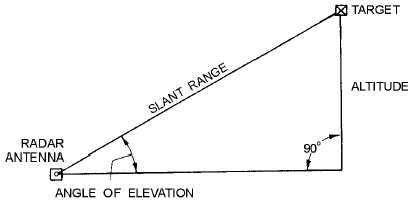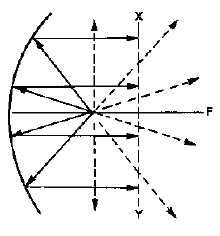3-17
and the angle of elevation is 45 degrees, the altitude is 1,414.2 feet (2,000 .7071). In some radar
equipments that use antennas that may be moved in elevation, altitude determination is automatically
computed.
Figure 3-16.—Radar determination of altitude.
PARABOLIC REFLECTORS
A SPHERICAL WAVEFRONT spreads out as it travels and produces a pattern that is neither too
sharp nor too directive. On the other hand, a PLANE wavefront does not spread out because all of the
wavefront moves forward in the same direction. For a sharply defined radar beam, the need exists to
change the spherical wavefront from the antenna into a plane wavefront. A parabolic reflector is one
means of accomplishing this.
Radio waves behave similarly to light waves. Microwaves travel in straight lines as do light rays.
They may be focused and/or reflected just as light rays can. In figure 3-17, a point-radiation source is
placed at the focal point F. The field leaves this antenna with a spherical wavefront. As each part of the
wavefront reaches the reflecting surface, it is shifted 180 degrees in phase and sent outward at angles that
cause all parts of the field to travel in parallel paths. Because of the shape of a parabolic surface, all paths
from F to the reflector and back to line XY are the same length. Therefore, all parts of the field arrive at
line XY the same time after reflection.
Figure 3-17.—Parabolic reflector radiation.




